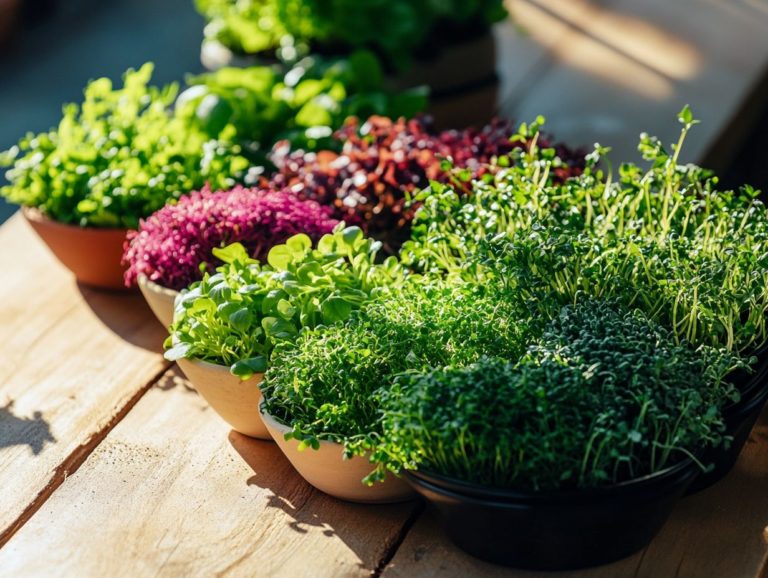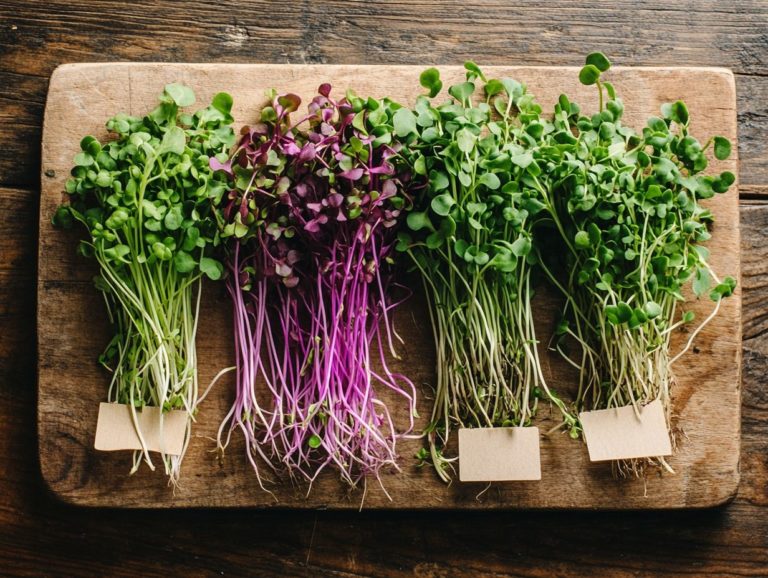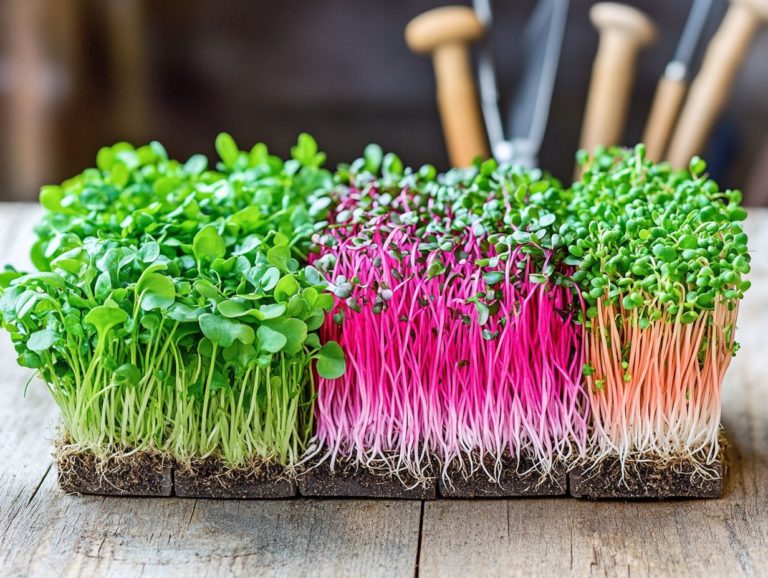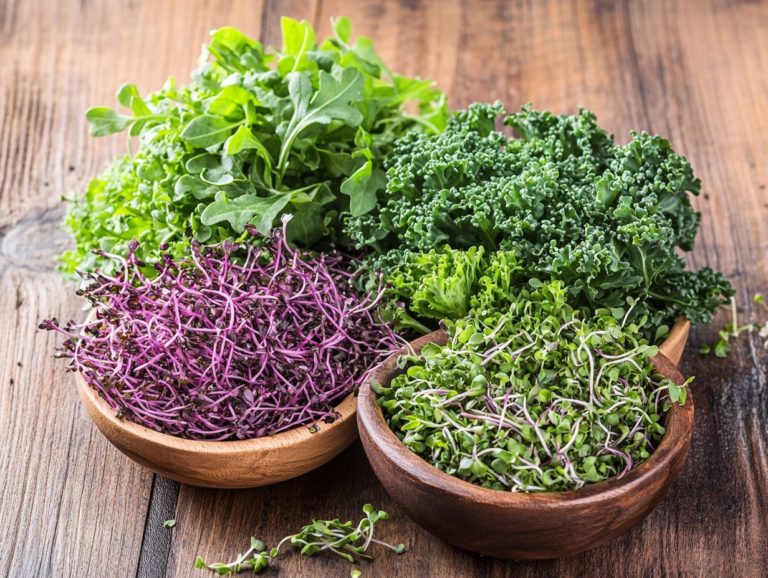Understanding the Antioxidant Capacity of Microgreens
Microgreens are small, vibrant greens bursting with flavor and brimming with nutrients and antioxidants, making them an exceptional enhancement to your diet.
In this article, you ll discover what microgreens are, their distinctive traits, and the various types that flaunt impressive antioxidant profiles. You’ll learn how growing conditions can impact their health benefits and uncover simple ways to incorporate these colorful greens into your meals.
From mouthwatering recipes to the latest research on their potential health benefits, this guide equips you with everything you need to know about microgreens!
Contents
- Key Takeaways:
- What are Microgreens?
- Antioxidants in Microgreens
- Factors Affecting Antioxidant Capacity
- How to Incorporate Microgreens into Your Diet
- Potential Health Benefits of Microgreens
- Frequently Asked Questions
- What are microgreens?
- What is the antioxidant capacity of microgreens?
- How do microgreens compare to other greens in terms of antioxidant capacity?
- What nutrients contribute to the antioxidant capacity of microgreens?
- Why are microgreens considered a superfood for their antioxidant capacity?
- How can I incorporate microgreens into my diet to benefit from their antioxidant capacity?
Key Takeaways:

- Microgreens are small and nutrient-rich plants that are harvested just after sprouting. They are packed with antioxidants, including vitamins A, C, and E, and may offer a wide range of healthy benefits.
- The antioxidant capacity of microgreens can vary depending on factors such as growing conditions and plant variety. To maximize their benefits, choose organic and fresh microgreens and store them properly.
- Incorporating microgreens into your daily diet is an easy and delicious way to boost your antioxidant intake. Add them to salads, sandwiches, smoothies, and more for a nutritious and flavorful twist on your favorite dishes!
What are Microgreens?
Microgreens are young, edible plants harvested just after the first true leaves appear.
They showcase a stunning array of vibrant colors and bold flavors. Varieties like radish and broccoli are popular for their impressive nutritional benefits and quick growth cycles, influenced by optimal conditions like light intensity and nutrient levels.
These little greens also enhance the visual appeal of your dishes and deliver a remarkable nutrient boost and antioxidant capacity, positioning them as essential components in health-conscious diets.
Definition and Characteristics
Microgreens are the immature plants you ll want to harvest shortly after germination. Packed with flavor and nutrients, they make a delightful addition to a wide array of dishes.
These tiny greens display an impressive spectrum of vibrant colors, from deep greens to vivid purples, making them not just tasty but visually captivating. Their flavors can surprise you; take arugula microgreens, for example, which deliver a peppery kick, while basil microgreens offer a sweet, aromatic touch.
Nutritionally, microgreens hold higher concentrations of vitamins, minerals, and antioxidants than their mature counterparts. Their notable beneficial plant compounds include sulforaphane, phenolics, and ascorbic acid, which may offer various health benefits.
By incorporating these petite plants into your meals, you ll not only elevate the flavor but also enhance the nutritional quality of your diet, paving the way for a healthier lifestyle!
Antioxidants in Microgreens
Microgreens are a powerhouse of antioxidants, essential for fighting oxidative stress, which can harm your cells, and enhancing your overall well-being. The antioxidant activity in these tiny greens often surpasses that of their fully grown counterparts, highlighting an impressive concentration of bioactive compounds like phenolics and ascorbic acid, contributing to their total antioxidant activity.
This positions microgreens not merely as a nutritional boost but as a vital contributor to your health benefits.
Types and Benefits
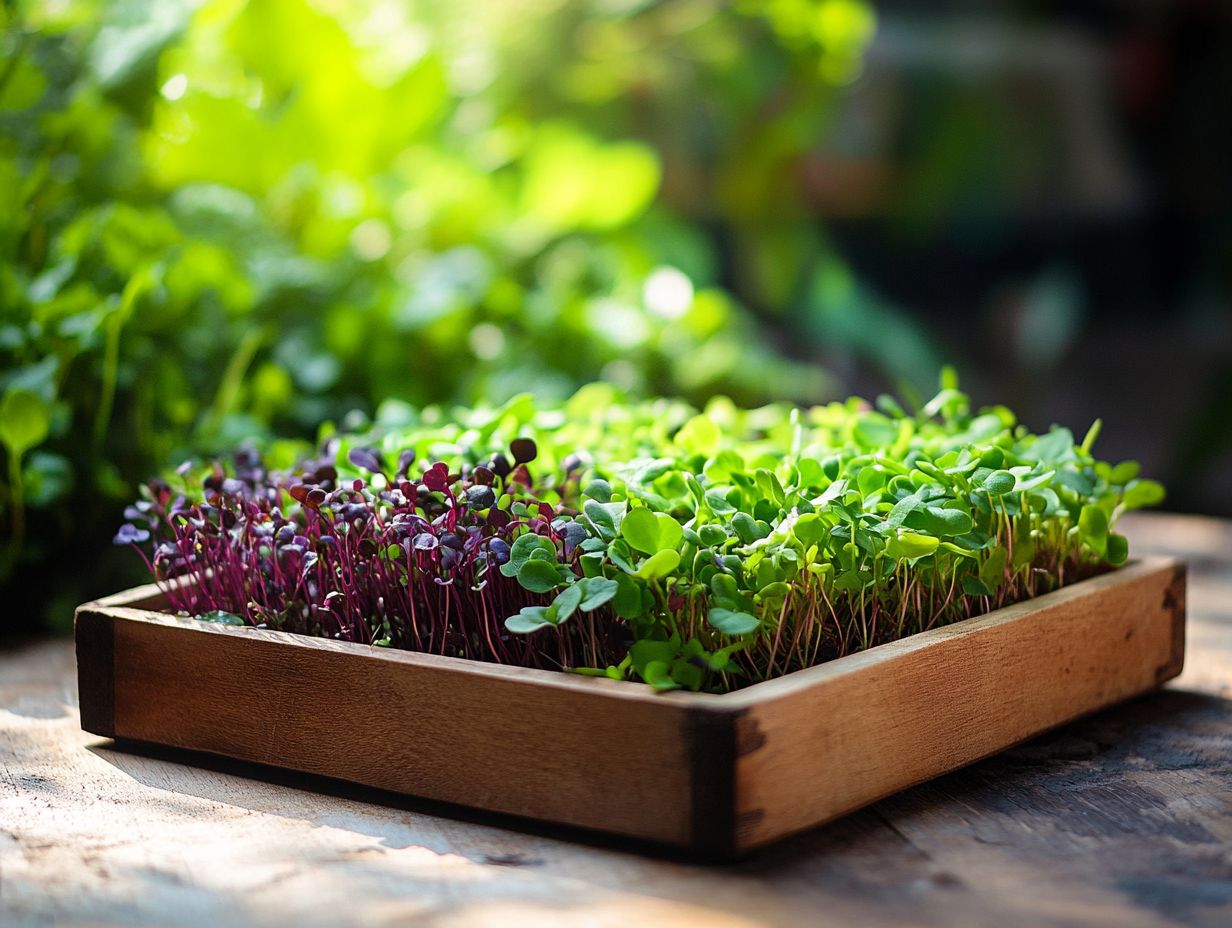
You ll find a plethora of microgreens varieties, each bringing its own distinctive benefits and flavors to the table. Take radish microgreens, for instance; they re bursting with antioxidants.
Broccoli microgreens are a vitamin powerhouse. Among these tasty options, pea shoots stand out for their impressive protein content and essential amino acids, making them an excellent choice for anyone embracing a plant-based diet.
Then there are sunflower microgreens, celebrated not only for their delightful crunch that elevates any salad but also for their substantial vitamin E content, which is vital for maintaining healthy skin.
Don t overlook microgreens like beet greens, either. They re loaded with nitrates that support cardiovascular health by enhancing blood flow.
With their concentrated nutrient profiles, these tiny greens are culinary powerhouses, effortlessly elevating your meals while contributing to your overall well-being.
Their vibrant hues often signal a rich supply of antioxidants, further solidifying their role in promoting a healthy lifestyle.
Factors Affecting Antioxidant Capacity
The antioxidant capacity of microgreens can be greatly influenced by several key factors, including light conditions, storage duration, storage effects, and growth parameters.
When grown under optimal light conditions specifically blue/red light microgreens display enhanced antioxidant activity, thanks to active growth processes.
Recognizing these factors is essential for you to fully capitalize on the health benefits offered by these nutrient-dense greens.
Growing Conditions and Varieties
Different growing conditions, such as light intensity, growth light, and the medium you choose be it growing plants in water without soil or soil grown play a pivotal role in shaping the quality of your microgreens.
To ensure optimal growth rates and flavor development, it s essential to provide adequate light. For instance, microgreens like basil and arugula flourish under full-spectrum grow lights that mimic natural sunlight, while other varieties might thrive under different light spectrums.
Nutrient levels are equally critical; hydroponic systems often require a carefully balanced nutrient solution to promote vigorous growth, whereas soil cultivation naturally supplies essential minerals.
Delving into these dynamics is key, as each microgreen variety comes with its own unique requirements. By grasping these nuances, you can pave the way for a truly abundant harvest.
How to Incorporate Microgreens into Your Diet
Get ready to supercharge your meals with microgreens! These tiny greens not only boost nutrition but also add colorful flavors to every bite.
Incorporating microgreens into your diet is not only effortless but also immensely rewarding. They elevate the nutritional quality of your meals, infusing vibrant flavors and delightful textures.
Whether you re tossing them into salads or blending them into smoothies, the possibilities are endless when it comes to enhancing your culinary experience. Sensory evaluation shows that microgreens significantly improve the taste and appearance of your dishes, making them a cherished choice for food enthusiasts like yourself.
Don’t miss out on these nutrient-packed additions to your diet. They can transform your meals and support your well-being like never before!
Start today and enjoy the vibrant, healthy benefits of microgreens in your kitchen!
Recipes and Serving Suggestions
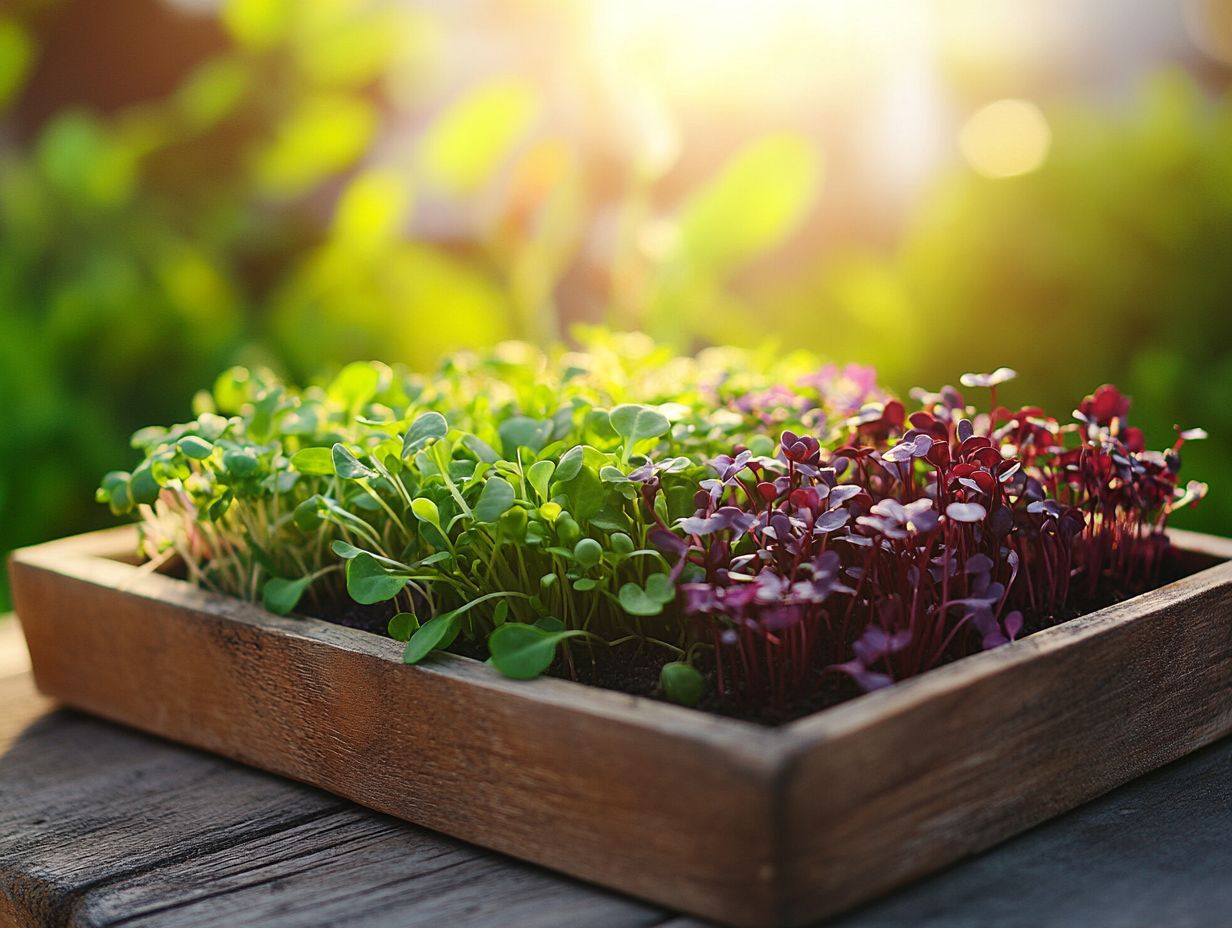
Microgreens can be your secret weapon in the kitchen. They creatively enhance a variety of recipes while boosting both nutritional value and visual appeal in dishes like salads, sandwiches, and smoothies.
These tiny greens pack a lot of flavor and are brimming with essential nutrients. They can transform everyday meals into culinary masterpieces. For example, by incorporating sunflower or pea microgreens into a simple salad, you elevate it into a gourmet experience, adding delightful crunch and freshness.
Sandwiches become vibrant and nutritious when you layer in radish or broccoli microgreens, contributing a peppery flavor and an array of vitamins. Don t forget about smoothies; just a handful of microgreens blends in seamlessly, providing an excellent source of antioxidants.
Whether you aim to enhance a dish s flavor profile or boost its health benefits, microgreens are a versatile ingredient that deserves a spot in your kitchen.
Potential Health Benefits of Microgreens
The potential health benefits of microgreens are well-documented. They have an impressive nutritional profile packed with antioxidants, vitamins, and minerals, as well as significant differences in plant compounds.
Research suggests that adding these tiny greens to your diet can enhance your overall health and wellness. They are an invaluable addition to your cooking options, especially when considering consumer preference.
Research and Evidence
Numerous studies underscore the remarkable health benefits of microgreens, particularly their impressive antioxidant levels and nutritional profile.
A significant study from the University of Maryland explored various microgreens, such as arugula, radish, and broccoli. The findings revealed that these petite greens have higher concentrations of vitamins and minerals than their fully grown counterparts. Researchers measured the nutrient levels across different varieties, discovering that microgreens can provide up to 40 times more nutrients. For more insights, check out understanding the health benefits of microgreens.
A systematic review in the Journal of Agricultural and Food Chemistry established a connection between microgreen consumption and reduced risks of chronic diseases. This reinforces their status as a nutritional powerhouse and supports the inclusion of these nutrient-dense plants in your daily diet, promising enhanced health benefits, including unlocking the antioxidant power of microgreens.
Summary and Recommendations
Microgreens are a true powerhouse of nutrition. They offer an impressive array of health benefits thanks to their rich antioxidant content and exceptional nutritional profile.
These tiny greens are not only brimming with vitamins and minerals; they provide essential plant compounds that combat oxidative stress and inflammation. Incorporating them into your meals can transform your salads or add a vibrant flair to sandwiches and smoothies. To learn more about their benefits, check out this guide on understanding the nutritional profile of microgreens.
By regularly including microgreens in your diet, you can boost your overall health, support your immune system, and promote better digestion. The significance of these small but mighty greens should not be underestimated. Dive into your local markets or try growing your own at home for the freshest experience!
Frequently Asked Questions
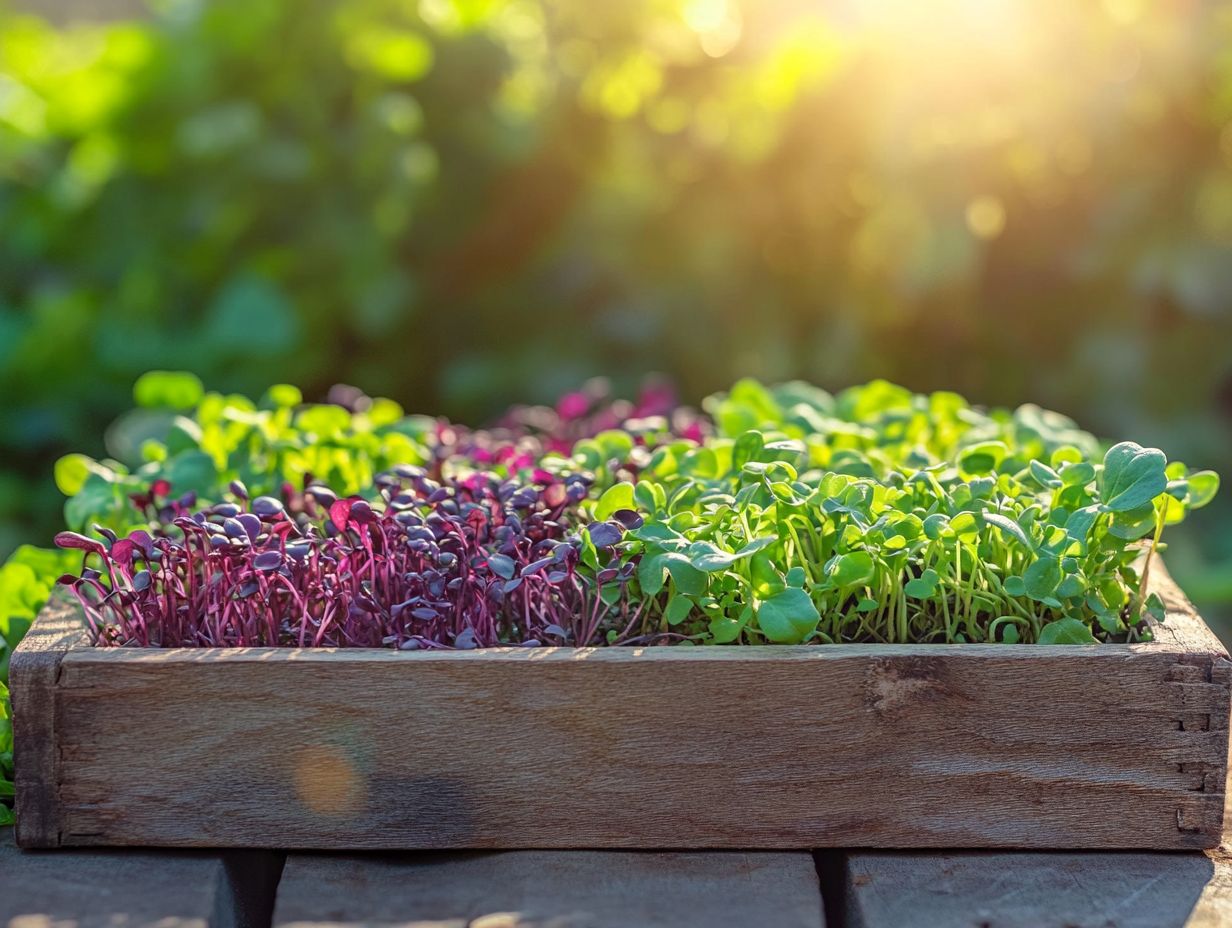
What are microgreens?
Microgreens are young vegetable greens that are harvested after sprouting but before they fully mature. They are typically grown from the seeds of herbs, vegetables, or grains and are known for their intense flavor and concentrated nutrient content.
What is the antioxidant capacity of microgreens?
Microgreens have a strong antioxidant capacity. They help fight oxidative stress, which happens when free radicals outnumber antioxidants. This imbalance can cause cell damage and lead to chronic diseases.
How do microgreens compare to other greens in terms of antioxidant capacity?
Studies show that microgreens have a higher antioxidant capacity than their mature counterparts, like full-grown vegetables and herbs. Some microgreens may have up to 40 times more nutrients than their mature versions.
What nutrients contribute to the antioxidant capacity of microgreens?
Microgreens are packed with various nutrients that boost their antioxidant capacity. Key nutrients include vitamins C, E, and K, along with beta-carotene, lutein, and zeaxanthin plant chemicals that provide health benefits.
Why are microgreens considered a superfood for their antioxidant capacity?
Microgreens are labeled as a superfood due to their high nutrient density and antioxidant capacity. They offer a concentrated source of essential vitamins and minerals, linked to potential health benefits, including reduced risk of chronic diseases and overall wellness.
How can I incorporate microgreens into my diet to benefit from their antioxidant capacity?
Incorporating microgreens into your diet is fun and easy! Try adding them to salads, smoothies, or sandwiches. They can even be a nutritious snack on their own!
Don’t wait to enjoy the incredible benefits of microgreens! Start experimenting with these nutrient-packed greens today and boost your health!

